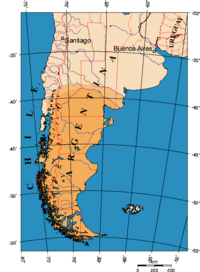
Photo from wikipedia
Abstract We studied the northern tip of the Austral-Magallanes basin in the Southern Patagonian Andes, between the Buenos Aires Lake and the Mayer River at 46°35′ SL and 48°35′ SL,… Click to show full abstract
Abstract We studied the northern tip of the Austral-Magallanes basin in the Southern Patagonian Andes, between the Buenos Aires Lake and the Mayer River at 46°35′ SL and 48°35′ SL, respectively. Proposed objectives were: i) to differentiate Mesozoic-Cenozoic tectonostratigraphic units and, ii) to characterize the different deformational events that took place in the area linked to a variable regional geodynamic context. Sandstones provenance analysis was performed on the Aptian - Albian compressive retroarc deposits and Cenozoic foreland deposits. Studied samples were classified using tectonic discrimination diagrams which show: i) for Cretaceous rocks a dominant sediment source from a recycled orogen and, to a lesser extent, a dissected to transitional arc whereas ii) the Cenozoic rocks show a magmatic arc provenance. According to the performed analyses, the evolution of the northern sector of the Austral-Magallanes basin is proposed to include four tectonostratigraphic units related to: i) a Late Jurassic rift stage; ii) a Berriasian – Barremian thermal subsidence stage; iii) an Aptian – Albian compressive retroarc stage; and iv) a Miocene foreland stage s.s. The Late Cretaceous-Paleocene was a time for compression and uplift, represented in the study zone by a paraconcordance/angular unconformity with an extended hiatus between Albian/Cenomanian rocks and the Eocene.
Journal Title: Journal of South American Earth Sciences
Year Published: 2019
Link to full text (if available)
Share on Social Media: Sign Up to like & get
recommendations!